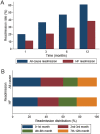Hospital readmissions of patients with heart failure from real world: timing and associated risk factors
- PMID: 33599109
- PMCID: PMC8006673
- DOI: 10.1002/ehf2.13221
Hospital readmissions of patients with heart failure from real world: timing and associated risk factors
Abstract
Aims: This study aims to investigate hospital readmissions and timing, as well as risk factors in a real world heart failure (HF) population.
Methods and results: All patients discharged alive in 2016 from Sahlgrenska University Hospital/Östra, Gothenburg, Sweden, with a primary diagnosis of HF were consecutively included. Patient characteristics, type of HF, treatment, and follow-up were registered. Time to first all-cause or HF readmission, as well as number of 1 year readmissions from discharge were recorded. In total, 448 patients were included: 273 patients (mean age 78 ± 11.8 years) were readmitted for any cause within 1 year (readmission rate of 60.9%), and 175 patients (mean age 76.6 ± 13.7) were never readmitted. Among readmissions, 60.1% occurred during the first quarter after index hospitalization, giving a 3 month all-cause readmission rate of 36.6%. HF-related 1 year readmission rate was 38.4%. Patients who were readmitted had significantly more renal dysfunction (52.4% vs. 36.6%, P = 0.001), pulmonary disease (25.6% vs. 15.4%, P = 0.010), and psychiatric illness (24.9% vs. 12.0%, P = 0.001). Number of co-morbidities and readmissions were significantly associated (P < 0.001 for all cause readmission rate and P = 0.012 for 1 year HF readmission rate). Worsening HF constituted 63% of all-cause readmissions. Psychiatric disease was an independent risk factor for 1 month and 1 year all-cause readmissions. Poor compliance to medication was an independent risk factor for 1 month and 1 year HF readmission.
Conclusions: In our real world cohort of HF patients, frequent hospital readmissions occurred in the early post-discharge period and were mainly driven by worsening HF. Co-morbidity was one of the most important factors for readmission.
Keywords: Co-morbidities; Heart failure (HF); Readmissions.
© 2021 The Authors. ESC Heart Failure published by John Wiley & Sons Ltd on behalf of European Society of Cardiology.
Conflict of interest statement
The authors declare no conflict of interest.
Figures



References
-
- Ponikowski P, Voors AA, Anker SD, Bueno H, Cleland JG, Coats AJ, Falk V, González‐Juanatey JR, Harjola VP, Jankowska EA, Jessup M, Linde C, Nihoyannopoulos P, Parissis JT, Pieske B, Riley JP, Rosano GM, Ruilope LM, Ruschitzka F, Rutten FH, van der Meer P, Authors/Task Force Members., Document Reviewers . 2016 ESC Guidelines for the diagnosis and treatment of acute and chronic heart failure: The Task Force for the diagnosis and treatment of acute and chronic heart failure of the European Society of Cardiology (ESC). Developed with the special contribution of the Heart Failure Association (HFA) of the ESC. Eur J Heart Fail 2016; 18: 891–975. - PubMed
-
- Paren P, Schaufelberger M, Bjorck L, Lappas G, Fu M, Rosengren A. Trends in prevalence from 1990 to 2007 of patients hospitalized with heart failure in Sweden. Eur J Heart Fail 2014; 16: 737–742. - PubMed
-
- Davison BA, Metra M, Senger S, Edwards C, Milo O, Bloomfield DM, Cleland JG, Dittrich HC, Givertz MM, O'Connor CM, Massie BM, Ponikowski P, Teerlink JR, Voors AA, Cotter G. Patient journey after admission for acute heart failure: length of stay, 30‐day readmission and 90‐day mortality. Eur J Heart Fail 2016; 18: 1041–1050. - PubMed
-
- Statistics Sweden . The future population of Sweden 2018–2070. Demographic reports 2018; 1.
-
- Ryden‐Bergsten T, Andersson F. The health care costs of heart failure in Sweden. J Intern Med 1999; 246: 275–284. - PubMed
Publication types
MeSH terms
LinkOut - more resources
Full Text Sources
Other Literature Sources
Medical
Research Materials
Miscellaneous

